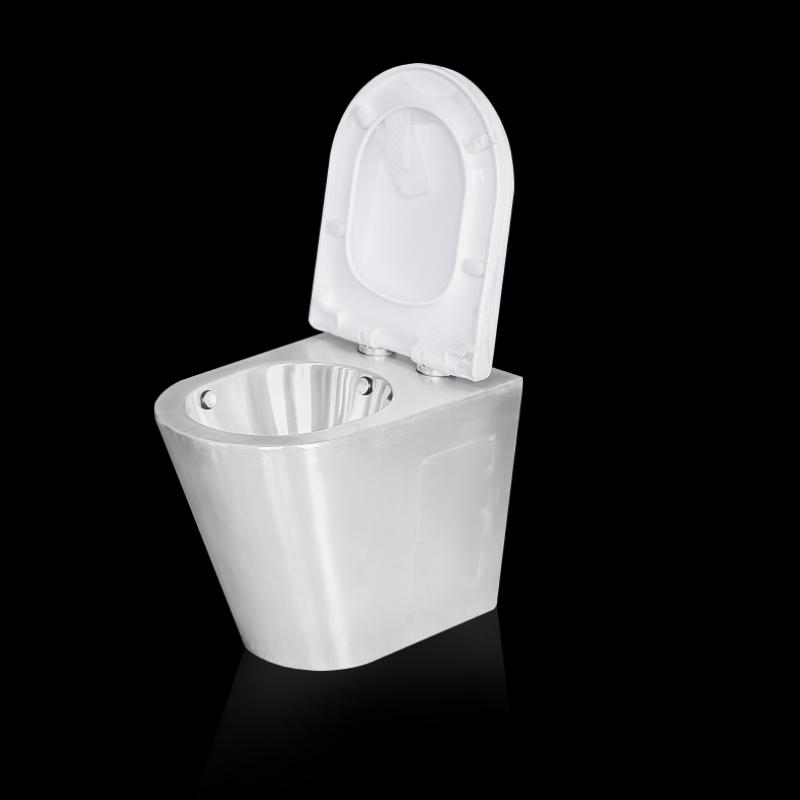Stainless steel toilets are becoming increasingly popular in both residential and commercial settings due to their durability, hygienic properties, and sleek appearance. However, one common concern among potential users and facility managers is whether these toilets are prone to scratches. In this detailed guide, we’ll explore the scratch resistance of stainless steel toilets, particularly in environments like public toilets where high usage and varied cleaning practices can impact their longevity.
Stainless steel toilets are manufactured using a combination of chromium, nickel, and iron, which gives them their distinctive shiny, corrosion-resistant surface. Unlike ceramic toilets, which are prone to chipping and staining, stainless steel toilets offer a hygienic and easy-to-clean alternative. Their non-porous surface makes them ideal for high-traffic areas such as public toilets, where maintaining cleanliness is a top priority.
The material’s durability is one of its key advantages. Stainless steel is known for its strength and resistance to wear and tear, making it suitable for environments where it may be subjected to rough use. However, the question remains: how well do these toilets hold up against scratches?
The scratch resistance of stainless steel toilets stems from the material’s hardness and its ability to form a protective oxide layer. When stainless steel is scratched, this layer can often repair itself, minimizing the visibility of minor damage. This self-healing property is particularly beneficial in public toilets, where scratches from cleaning tools or accidental impacts are common.
However, the scratch resistance of stainless steel can vary depending on factors such as the grade of steel used, surface finish, and maintenance practices. Higher-grade stainless steel, such as Type 304 or 316, offers superior resistance to corrosion and scratches compared to lower-grade alternatives.
In public toilet environments, stainless steel toilets face several challenges that can lead to scratches:
1. **Cleaning Tools**: Harsh scrubbers, steel wool, or abrasive cleaning pads can easily scratch the surface of public toilets. Facility managers must ensure that appropriate cleaning tools are used to avoid damaging the finish.
2. **Chemical Cleaners**: While stainless steel is resistant to many chemicals, certain harsh cleaning agents can degrade the surface over time, making it more susceptible to scratches.
3. **Foot Traffic and Vandalism**: In high-traffic public toilets, accidental impacts from feet, shoes, or objects can cause scratches. Vandalism, though less common, can also result in significant surface damage.
4. **Environmental Factors**: Exposure to moisture, humidity, and corrosive substances can weaken the stainless steel’s protective layer, increasing the likelihood of scratches.
When selecting a stainless steel toilet for a public toilet, consider the environment and expected usage to choose the most appropriate finish.
Stainless steel toilets outperform these materials in terms of durability, hygiene, and long-term maintenance costs, making them an excellent choice for public toilets.
Case Studies: Stainless Steel Toilets in High-Traffic Public Toilets
Real-world examples highlight the performance of stainless steel toilets in challenging environments:
Public Transit Stations
In busy train and bus stations, stainless steel toilets withstand constant use and rigorous cleaning schedules. Their resistance to scratches and corrosion ensures they maintain a clean, professional appearance despite heavy foot traffic.
Schools and Universities
Educational institutions benefit from the durability of stainless steel toilets, which can withstand the rough use typical in student environments. Proper maintenance helps minimize scratches and extends the lifespan of these fixtures.
Airports and Shopping Centers
High-traffic areas like airports and shopping centers rely on public toilets for their ability to maintain hygiene and appearance. Regular maintenance and appropriate cleaning practices help prevent scratches and keep these toilets looking pristine.
## Frequently Asked Questions About Stainless Steel Toilets
### Are stainless steel toilets more scratch-resistant than ceramic toilets?
Yes, stainless steel toilets are generally more scratch-resistant than ceramic toilets. Their non-porous surface and self-healing properties make them ideal for environments where durability is a priority.
### Can scratches on public toilets be repaired?
Minor scratches can often be polished out using stainless steel polish. Deep scratches may require professional assessment to determine if they affect the toilet’s structural integrity.
### How often should public toilets be cleaned in public settings?
In public toilets, daily cleaning is recommended to maintain hygiene and prevent buildup. Weekly deep cleaning helps address stubborn stains and ensures the toilets remain in optimal condition.
### Are there eco-friendly cleaning options for stainless steel toilets?
Yes, many eco-friendly cleaners are suitable for stainless steel. Look for products free of harsh chemicals that could damage the surface over time.
Stainless steel toilets are a durable and hygienic choice for both residential and public settings. While they are not entirely immune to scratches, their resistance to wear and tear makes them superior to many alternative materials. By following proper maintenance practices and selecting the appropriate surface finish, facility managers can ensure that stainless steel toilets in public environments remain scratch-free and functional for years to come.
Whether you’re designing a new public toilet facility or upgrading existing fixtures, stainless steel toilets offer a practical, long-lasting solution that balances aesthetics, durability, and ease of maintenance. With careful selection and proper care, these toilets will continue to serve efficiently in even the most demanding environments.

